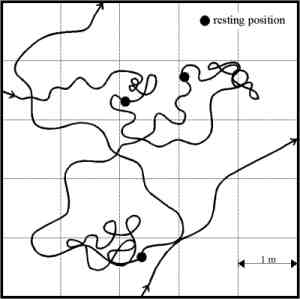|
The foraging behaviour of males was quite different from that of females. The former usually stayed no longer on the ground or on stems than 5 - 10 sec., they otherwise showed a constant migratory restlessness, primarily aimed at the discovery of females. They also searched for prey during their flights and captured their victims in the air. These scouting flights lasted for about 5 - 15 m on average (sometimes more than 200 m) and 30 - 60 cm above the ground. The direction of the flights changed constantly and the area was extensively reconnoitred during these patrols (Fig. 3). Musso (1972) also describes this behaviour.
The females were more territorial, staying for longer times at the their foraging position (usually facing upwards on stems, sometimes on the ground). They only flew if they saw potential prey or if they were disturbed (mostly by males).
|

| Fig. 3: Dasypogon diadema, flight path
and resting position of a male. |
|